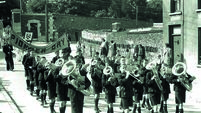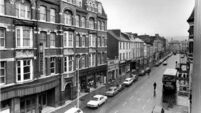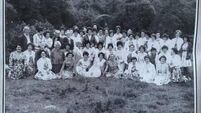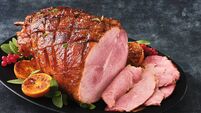Memories of go-karts, box-carts and hill trolleys on the streets of Cork
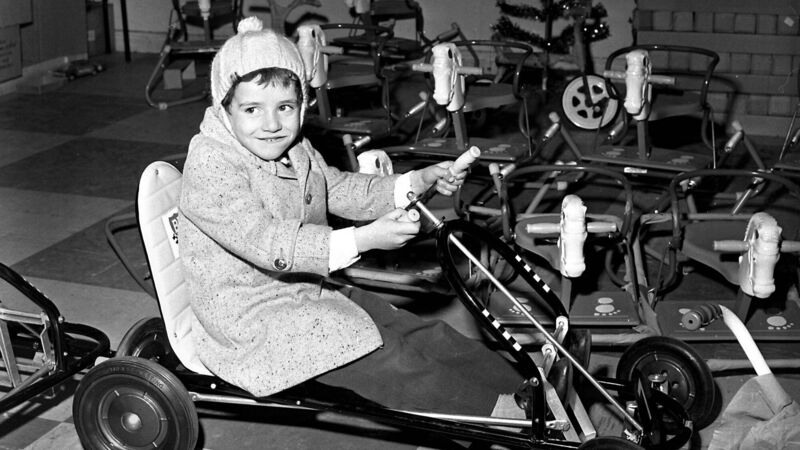
WHIZZ-KID: A child on a go-kart at Dunnes Stores in Cork in December, 1964.
I WAS threading my way through the bushes on a quiet country lane the other day, exploring the ruin of an old mill, and came across a very nice little fairy cycle and a doll’s pram. Both were in almost-new condition, but clearly had been dumped when their owners grew too big for them. I thought it was a shame. Back before we all got too posh to know ourselves, those toys would have been passed on, passed down, traded across, and, when really battered and well loved, used for spare parts.
For what, you ask? Well, for trolleys, go-karts, whatever you might know them as, of course!
Back in the 1950s and ’60s, a set of wheels, especially with good axles attached, were much in demand on the juvenile trading market. One would imagine they had been so from the turn of the 19th century, when make-your-own was part of everyday life.
In fact, children of the 1920s and ’30s in inner-city slums would have regarded the invention of said wheel as being for just one reason —making go-karts. Old movies of life in industrial Yorkshire or Lancashire show glimpses of half a dozen home-made wheelies running races down a steep, cobbled street. How they must have bumped young spines!
Some called them go-karts. Others box-carts or hill trolleys. Early ones were often known as ‘billy carts’ in memory of those small ones drawn by goats and holding a milk churn.
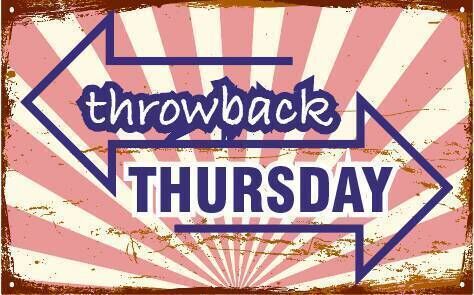
One name that sticks in my mind for some reason is ‘trolley-wagger’ — does that sound familiar to any reader? But in Cork one designation stood out, a truly Corkonian one: the ‘steerin-a’.
It is part of our highly individual Leeside culture that many words are suffixed with a final ‘a’ or ‘ah’, as in “waxin’ up a gazz-ah”, going down to the beach with your “bathin-ahs” tucked under your arm, or disputing the relative merits of the city’s two major brass bands, the Barrack-ah and the Butter-ah. (More examples from readers will be delightedly welcomed.)
The carts were used for hauling turf or coal from the depot to your home, as Noel Magnier recalls in his memoirs, for pulling small brothers and sisters around before they had learned to walk (or couldn’t walk — remember Daniel Day-Lewis as Christy Brown in My Left Foot?), but mostly, and chiefly, for risking your life on downhill racing.
Rome may have its legendary seven hills, but Cork city could show it a few, and then some. Wherever you look, there is a likely hill inviting adventure. Or there was, back when kids actually looked for adventure rather than staying home and staring at a flickering little screen.
I remember at about the age of seven hunting everywhere, because I wanted to make my own go-kart, but somebody’s brother had always been there before me and secured the requisite broken-down pram or push-chair.
When I did finally run some ball-bearing wheels to ground, it was the dickens’ own job to find a way of fastening them on to a wooden axle.
And then, if you used them on a gravel driveway, they got clogged up in no time.
Speaking to my older brother Tommy about it this week, I was amazed to discover that he had been making these from an early age, and using them too, on the famous hills of Cork city.
“I got a board from Eustace’s timber yard on Leitrim Street, and the wheels from an old push- chair down the Coal Quay. You could use the axle from the push chair with the wheels and fix it in place with those ‘u’ shaped iron nails. Or you could get ball-bearing wheels — they were smaller, about the size of the lid of a two-pound jamjar.”
The axle was fixed to the centre front of the board with a long bolt and preferably two screw nuts, with enough looseness to allow for steering.

The trolley was pushed up laboriously to the top of Wellington Road, almost to St Luke’s Cross, and then could go all the way down at speed.
“The right-hand side, of course — the left-hand side had several sets of steps to adjust to the slope of the hill whereas the right-hand side sloped all the way as far as opposite York Hill.
“Those pram wheels would take you right along as far as York Street, but the ball bearing ones would slow down the minute you got on to the flat.”
Tommy remembers that there was one set of steps leading up to a house at the start of the flat part of Wellington Road — where the railings begin — and the bottom step was sloping. “It’s still there. You would always guide your ‘steerin’-a’ to go over that sloping step and give you a good exciting bump.”
So how in heck did he guide this superb, home-assembled Flying Corkman?
“You used your feet on the axle and pushed one way or the other. Some people used a rope attached to the axle but you got a far better result by using your feet.”
There speaks the voice of experience. Not Michael, Schumacher but a practical Cork child.
I asked innocently about brakes. “Brakes? You used your feet of course!”
Well, we did share a father who habitually either threw the car into reverse to stop, or steered it up on to a handy slope, where it came gently to a halt, so I shouldn’t have been surprised at this cavalier approach to safe driving. I just wish I had been closer to him in age, and maybe I could have gone out too. Or maybe not. Mothers tended to be a bit more protective of their girl children back then.
The most important thing to grasp about all these wildly exciting methods of achieving speed and thrills is that they were home-made, and cost very little or nothing.
Fathers were often drafted in to help, and the shed raided for leftovers, scraps, bits and bobs that had been kept because they were sure to “come in useful one day”.
If your ambition went as high as a paint job, then whatever was available in the almost-empty tins in the corner dictated the hue. (I remember decorating my first small bike with purple paint, using black tar tape as a highlight here and there. Was well pleased with it.)
Linda, who grew up in England, remembers that everybody had trolleys on their council estate when she was little. “The trolley was either rubbish or state of the art, according to how adept your dad was with tools! My dad, being an aircraft designer (albeit of the controls rather than the shape) was brilliant in ‘the shed’ and we had a really fast one!”
When you wanted or needed something back in the old days, you looked around for some way to make it, whether it was a fort or a doll’s bed. And items like push chairs and prams, and indeed toys, were not thrown on the scrap heap when you lost interest. They were passed on, passed down, continued their useful life until they fell apart.
And even then they were a valuable source of spare parts, be it a teddy bear’s eyes or a wing nut. What happened to our ability to use what was around us?
Back at the beginning of the 20th century, one researcher studied the games played by London street kids and found their imagination and creativity to be unparalleled. Everything and anything was pressed into use for games, from cherry pips to stones, lengths of string to a cap. He recorded no fewer than 30 different games that could be played with a boy’s cap alone!
One boy, born in 1923, remembered searching the streets with his friends for scrap wood, and asking at garages for old ball bearing wheels, so they could make their wagons. Why, oh why, don’t we do that now?
Yes, we virtuously take car loads to the recycling centres, and feel we have done our bit. We are exhorted to do just that. But bringing a pile of things you no longer want to a tip and emptying them into huge metal bins is not recycling. Recycling means re-using, repurposing. It emphatically should not mean dumping them.
They may have outlived their usefulness for you, but that doesn’t mean somebody else couldn’t use them.
Of course, today’s children wouldn’t dream of accepting a second-hand bike, a pre-loved tricycle. They want the latest brand name, not something that will get them from A to B in the traditional manner.
I asked a major Cork cycle dealer if they still traded in second-hand bikes. “Absolutely not,” was the reply. “No call for them.” End of story?
I cannot believe that. Have we lost all the tradition, all the commonsense of our forbears?
Do you have memories of your own wagon or ‘steerin-a?’ Please let me know! Email jokerrigan1@gmail.com, and play your part in recording our past in Throwback Thursday.
